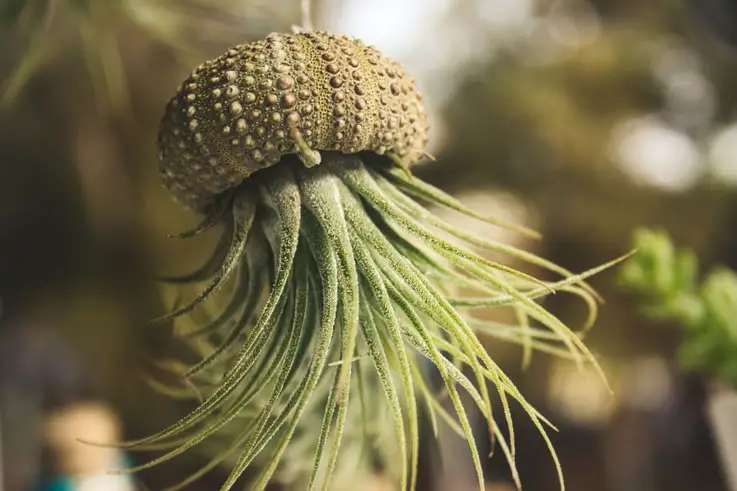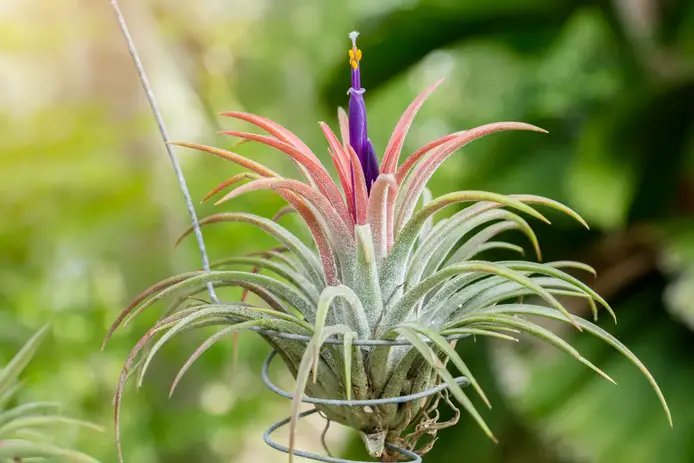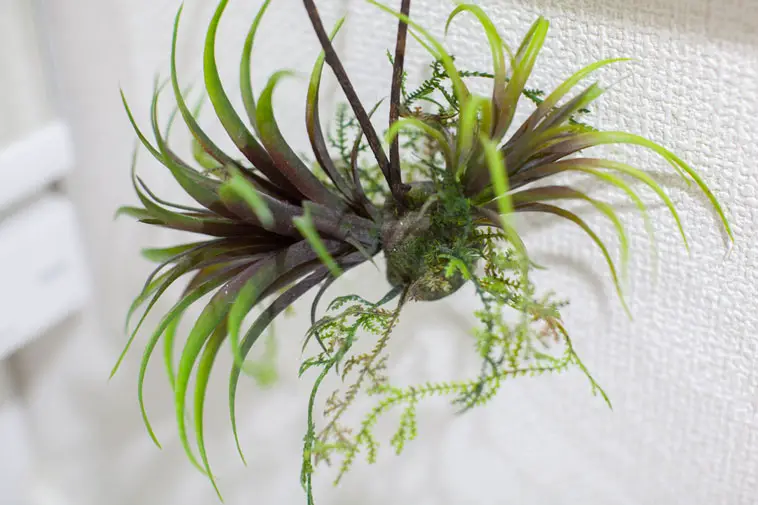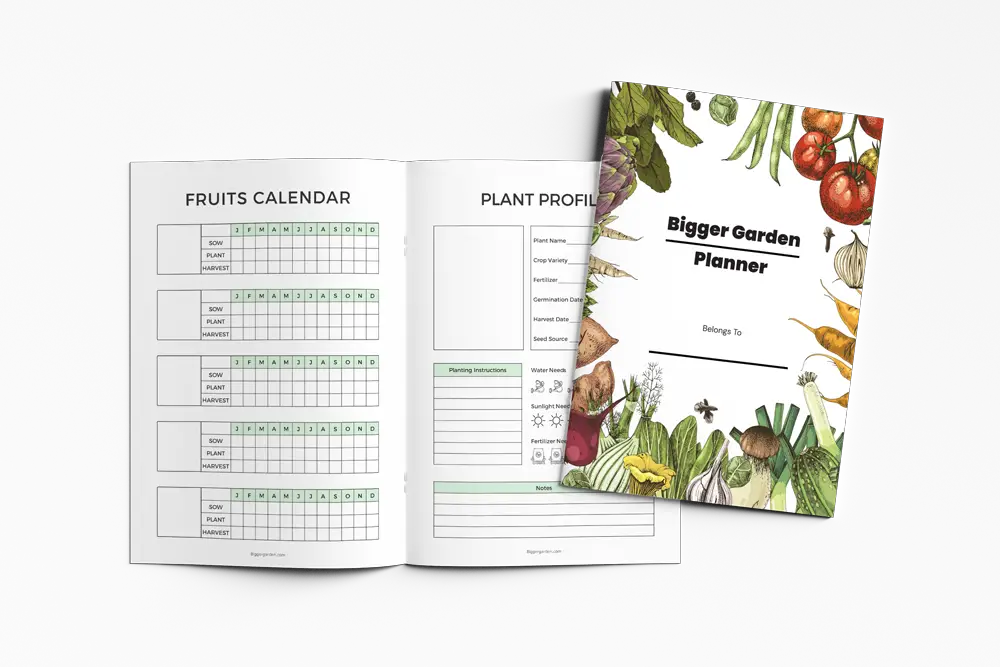10 Benefits of Air Plants Indoors

This post follows our research editorial guidelines.

I don’t need to be convinced to grow air plants – I love these weird little plants and their curling, sculptural leaves. But did you know there’s a whole host of reasons to bring them into your home? There’s more to these little charmers than meets the eye, so here’s my top ten reasons why every home or office should have an air plant gracing a sunny shelf.
Air plants in your home or office bring a host of benefits. They clean and freshen the air, and relieve stress. Tending to air plants is easy and rewarding, providing a sense of well-being, calm and connection. They propagate readily too, allowing you to share the benefits with those around you.

Table of Contents
1. Air Plants are Easy to Care For
Probably the number one reason to grow an air plant is simply how easy they are to care for. They’re tremendously forgiving of neglect, having evolved in arid sierras and cloud forests where water and nutrients are hard to come by.
Air plants can be found all through warmer regions of Central America, where they thrive anywhere there’s enough water and sunlight – high on rock faces and in trees, but also on man-made structures like power lines and buildings.
This adventurous spirit and forgiving biology makes them a stellar indoor plant for the novice gardener. All they want is the occasional watering and lots of light. Easy!
2. Air Plants Don’t Need a Pot
Air plants need no soil to grow. They’re epiphytes, capable of growing on almost any surface, or even without being rooted at all. They’ll quite happily thrive with their butts in the air, so to speak!
While this makes them easy to style, it brings with it a host of added benefits for the casual gardener. There’s never any need to repot them, for a start, dispensing with the need to worry about soil blends or securing the right pot for the job. And it makes it almost impossible to over-water them. There’s nowhere to hold excess water, so they’re great for those of us who have had less than stellar results with over-generous watering.
A lack of soil also means no soil borne diseases or pests. Pretty much all indoor plant collector wrestles with fungus gnats at some point or another – except those who only grow air plants. And you can’t develop a fungal infection if there’s nowhere for the fugus to live, either.
3. Are Plants are Fun to Style
I’m a huge fan of how elegant an air plant can be, but they’ve got a playful side. They’re great fun to decorate with, and there’s just so many different ways you can display them. No matter what kind of décor you prefer, air plants are easy to add without compromising on style. And because they grow quite happily without roots, they aren’t limited to surfaces that can hold a pot.
It’s popular to grow them in terrariums of cloches at the moment, with a crisp layer of shiny glass contrasting beautifully with their soft, fuzzy leaves. Classic arrangements include planting them into seashells, or even gluing them to magnets to display on kitchen refrigerators. They’re small enough to just hang out on a notice board in an office, or plopped on a desk by a jar of pencils. It’s easy to bring their charm anywhere you fancy.
“Because air plants can grow and anchor themselves to surfaces other than soil, they can be grown on or in a wide selection of surfaces. They can be attached to bark, shells, rocks, or placed in a shallow dish. Glass globes or creative planting stands are also available for displaying Tillandsia collections. They also may be hung on fishing line or thin wire from the ceiling or a rod to create an interesting display.”
Barbara H. Smith, Horticulture Extension Agent, Clemson University.
4. Air Plants are Non-Toxic
An alarming number of indoor plants are poisonous, especially to smaller members of our households. Curious children and playful pets can very easily come to harm if they take a nibble of many popular indoor plants. It pays to be careful when choosing plants to display in busy family homes.
Air plants are non-toxic, so they make an ideal plant for people with pets or small children roaming about. There are no poisonous chemicals in their leaves, and they don’t have thorns, barbs or other physical structures that can injure. They make excellent starter plants for budding junior gardeners, allowing them to nurture their love of plants along with the Tillandsia.

5. Air Plants Propagate Readily and Easily
Air plants propagate almost without any effort on our behalf. They have a reliable life cycle that leads to beautiful blooms, and once the flower dies so does the plant. I write a bit more on how air plants flower here, but in short, this beautiful bloom is a swan song, the last moment of beauty before the air plant succumbs to the grave.
But hiding in that tale of woe is a silver lining – the dying plant produces two or more replicas of itself, tiny pups that are as easy to grow as the parent. It required no special preparation, like cutting or rooting, and no special techniques or tricks. All it takes is a watchful eye and some patience, and an air plant will turn into a whole collection. They make great gifts too, allowing you to spread the joy of these tiny treasures.
6. There are Lots of Air Plants to Choose From
Tillandsias are a versatile family. They have a variety of sizes, colors and shapes brighten up any part of your home or office.
While most of us tend to think of the compact bulbous varieties like the T. ionantha, the genus contains a surprising variety. Some are small, like the T. capitata variety ‘Peach’, a small perky pink variety that only reaches an inch or two tall. Others can be sprawling, capable of reaching three feet or more across like the silvery T. Xerographica
Others are almost unrecognizable as air plants at all. Ball moss, a common sight growing wild in the south, is type of Tillandsia – T. recurvata to be precise! Its fuzzy silver clumps look more mossy than most species, leading to their common name. It’s the same story with Spanish Moss, which is neither Spanish or a moss! It’s known to botanists as Tillandsia usneoides and is native to the Americas. Both can be grown indoors, just like their more popular cousins.
Whether you need a small sweetie to perk up your desk or a great gauzy drapery of silver gray threads hanging in your window, there’s an air plant for the job!

7. Air Plants Can Improve Mental Health
A well decorated home or office is a great comfort, especially if your workload is stressful. But plants provide an extra edge when it comes to improving mental health.
A study from the University of Singapore discovered that minor plant care tasks gave the participants a sense of well-being, reducing their stress load and making them feel more accomplished and relaxed.
Not just that, but an environment rich in plant life can help with focus and productivity, too. Multiple studies have all demonstrated that having real plants in the working environment inproves satisfaction, especially in work places with no windows or view to the outside world. Creativity shoots up too when there’s something green and living sharing your workspace.
With so many of us toiling away at small offices, in delivery vehicles or even hot-desking at in a new spot each day, a potless, portable plant that fits in just about anywhere is a perfect companion. They’ll fit nicely on a desk or dash, a cheerful workmate to help you get through the day.
8. Air Plants Can Improve Air Quality
They may only be tiny, but air plants punch above their weight when it comes to improving the air around them. Tillandsias absorb toxins from the air, especially the really nasty ones like heavy metals and formaldehyde. They lock it away in their foliage, keeping it safely sequestered. Some species are so good at this that they’re used as a biological monitor, allowing environmental scientists to track changes in air pollution. One secured in the leaves, these hazardous chemicals are no longer a problem for those who breathe the same air as the Tillandsias.
Air plants also release oxygen all day long, rather than just during the day. Most plants draw carbon dioxide from the air during the day and exhale breathable oxygen, with the reverse occurring at night. But Tillandsias have a quirk to their biology that allows them to release oxygen all night long, freshening the air.
9. Air Plants Are Hypoallergenic
Air plants are one of the best plants for folks with allergies, as they shed no pollen or any other debris from their leaves. They also have no soil, so there’s zero chance mold or mildew will set up camp in their pot and start releasing irritating spores.
Furthermore, while most plants collect dust on their leaves and need to be washed or wiped clean, air plants actively trap dust, pollen and other allergens on the surface of their leaves before destroying it entirely. They digest it and turn it into fertilizer, so there’s no need to clean them. In fact, they clean the air for you!
10. Air Plants Aid in Healing
Termed “therapeutic horticulture”, there’s emerging evidence that recovery from illness, addiction and even surgery improves in lush, green environments.
The gentle, predictable activity of caring for plants like Tillandsias provides regular exercise. It’s also the type that can’t be put off, creating routines of activity key to recovery. People recovering from illness also benefit from the soothing act of tending to indoor plants. Caring for air plants instills feelings of well-being and connection with nature that helps speed up recovery, as well as making recovery more pleasant overall.
Tending air plants is also great for ailing older people and those struggling socially, allowing them to connect with others through shared interests. It’s a low impact hobby, great for people with physical limitations that’s easy to share with others. Indeed, it’s common to find bromeliad and Tillandsia groups all over the world, full of people from all walks of life connecting and building friendships around these weird, wonderful little plants.
Final thoughts
I’ve always loved the myriad of ways that air plants bring a little extra cheer to my home and office. Not only do they look great but they hold plenty of ben
